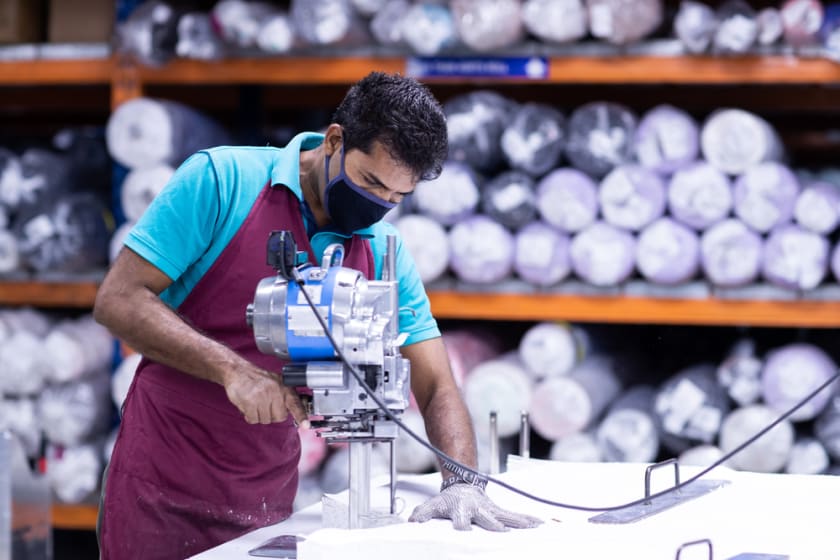Latest Technology Solutions for the Garment Manufacturing Industry



The technology used to make clothes must also advance to keep up with the ever-changing nature of fashion. Advancements in garment machinery technology have enabled businesses to cater to their customer's preferences. Examine the most recent innovations in the garment manufacturing industry and determine how to implement them in the Clothing industry.
Recent technological advancements have resulted in rapid transformations in manufacturing industries compared to the 18th-century Industrial Revolution that reshaped Western civilization. Of course, the fashion line is not an exception.
Emerging technologies offer exciting opportunities to those who are knowledgeable about commercial applications. Big data can make manufacturing more precise, local, and sustainable when combined with industrial automation and product technology innovations. New industrial technologies may offer advantages such as faster manufacturing, reduced waste, reshoring and distribution of manufacturing closer to the marketplace, and reduced carbon footprints.
Examples of recent advances in manufacturing technology include:
·Technological developments in sewing machines, such as laser-cutting, fusing, button-hole, and seam-bonding equipment;
· Robots that sew;
· Clothes that don't require sewing;
· Printing clothes with a 3D printer offers more promise than it currently has, especially for outfits with numerous layers.
· The advent of digital textile printing has allowed for the rapid and inexpensive production of unique custom designs.
Continue reading to learn more about the most recent innovations in the clothes industry and how technology affects the clothing market.
Trending Technology Solutions In Garment Manufacturing Industry
The garment industry's technology is growing upwards, which bodes well for the industry's future. When it comes to creating new products, artificial intelligence is making waves. Technology helps to optimize manufacturing supply chain operations by accelerating production, enabling intensive distribution, reimagining in-store and online buying, and creating customized items for particular customers. Machine learning, supply chain improvements, rapid data analytics, 3D capabilities, and individualized production runs are five cutting-edge technologies currently enjoying widespread adoption in the garment industry.
1. The Rise Of Robotic Manufacturing
A suitable replacement for hand-stitched clothing is not always possible. Fashion professionals are worth their weight in gold because of the exceptional quality they can produce through careful attention to detail. On the other hand, machine learning is improving garment design by eliminating the need for human involvement in critical manufacturing stages.

Robots have historically been effective at performing tedious, repetitive tasks in manufacturing assembly lines. However, the memory and agility of more contemporary robots make them more collaborative and programmable. It is not about eliminating jobs; instead, it is about educating people to be more productive and efficient and preventing harm to people by substituting robots for humans in dangerous areas.
Software Automation, an Atlanta-based company, created the Sewbot. The robot SewBot can sew clothes without the need for human assistance. Sewbot is already being used in the production of t-shirts. Perhaps this is the future of mass-producing necessities such as ready-made clothing.
2. Optimized Supply Networks
To flourish in the cutthroat clothing market, having short production periods, quick turnarounds, and flawless products is crucial. One hitch in your supply chain can cause manufacturing and delivery delays, disrupting sales and delaying the expansion of your business. Businesses can better predict, avoid, and maintain production control by simplifying the supply chain. Additionally, production delays and disruptions can be reduced by doing as many supply chain operations in-house as possible. This process includes getting the materials, packing them, and sending them off.
With consumers becoming more "antsy," reducing lead times is critical for timely deliveries. Many businesses have moved to do the entire operation "in-house" to improve speed and supply chain efficiency.
Everything can be handled in-house, from raw material procurement to conceptual and technical design, prototypes, full-scale production, and distribution. All teams must have real-time access to data and the most recent product versions to ensure everything runs smoothly.
3. Quick Data Analysis to Enable Swift Adaptation
Changing fashion trends are the apparel industry's primary force influencing private consumption. To meet your customer's needs and keep on top of the latest fashions and trends, you need fast access to reports and a thorough analysis of your production systems.
Every day, programmers improve and release new versions of software that use cloud computing in the manufacturing process to share comprehensive data with all stakeholders in the supply chain. As a result, everyone involved in the process, including all government agencies and partners, can access the data immediately.
Some businesses choose IQMS because it can track and record real-time production data as components are created and assigned to shop orders.
Now that cloud computing has expanded, businesses and industries worldwide may collaborate in real time. This can improve their ability to share information and have timely, fruitful, and transparent conversations.
4. 3-D Technology
Finding the correct size is an essential aspect of designing a new garment. This procedure can be significantly improved by using 3D rendering. To create the best possible design in real-time, 2D drawings and technical patterns can be converted into 3D computer simulations.
Creating and printing 3D models has far-reaching implications for many fields. These cutting-edge devices can quickly produce unique items from a wide range of materials. For example, when 3D printing is combined with other garment production techniques, it becomes possible to make anything from T-shirts and jeans to shoes and caps on demand.
Furthermore, 3D rendering may produce a more accurate representation of the finished product, allowing designers to make changes to the design in real-time to ensure that the finished product closely matches the design's parameters.
5. Sustainable Technology
3D printing technology has aided in the production of sustainable personalized clothing. Customers want clothes that are cut and fitted specifically for them. You earn from a secured sale as a supplier of made-to-order goods before you begin creating any item. Furthermore, custom fittings save money on materials and time in manufacturing.
Ten percent of all greenhouse gas emissions come from the textile and clothing sector. Therefore, more eco-friendly clothing production methods can substantially impact the longevity of whole economies. The most significant developments for boosting the protracted sustainability of the apparel sector are data science and recycling techniques.
Several forms of current technology could help the sustainable fashion sector. However, the bulk of these promising innovations requires significant time, money, and effort to reach their full potential. One of the major obstacles facing businesses keen to advance the cause of sustainability is finding the appropriate people in the correct positions to make the right decisions.
The worldwide apparel industry's total productivity has been significantly increased by technology. Organizations are using adopted technology to cut costs associated with product development and trial expansion.

Fashinza is your go-to source for innovative clothing production methods that are tailored to the fashion industry's ever-changing needs. Look no further than our cutting-edge garment manufacturing technology solutions if you're looking for textile manufacturing software. We'll help you streamline your operations and equip your employees with the tools they need with adaptable software that can keep up with your customers' changing needs.



















